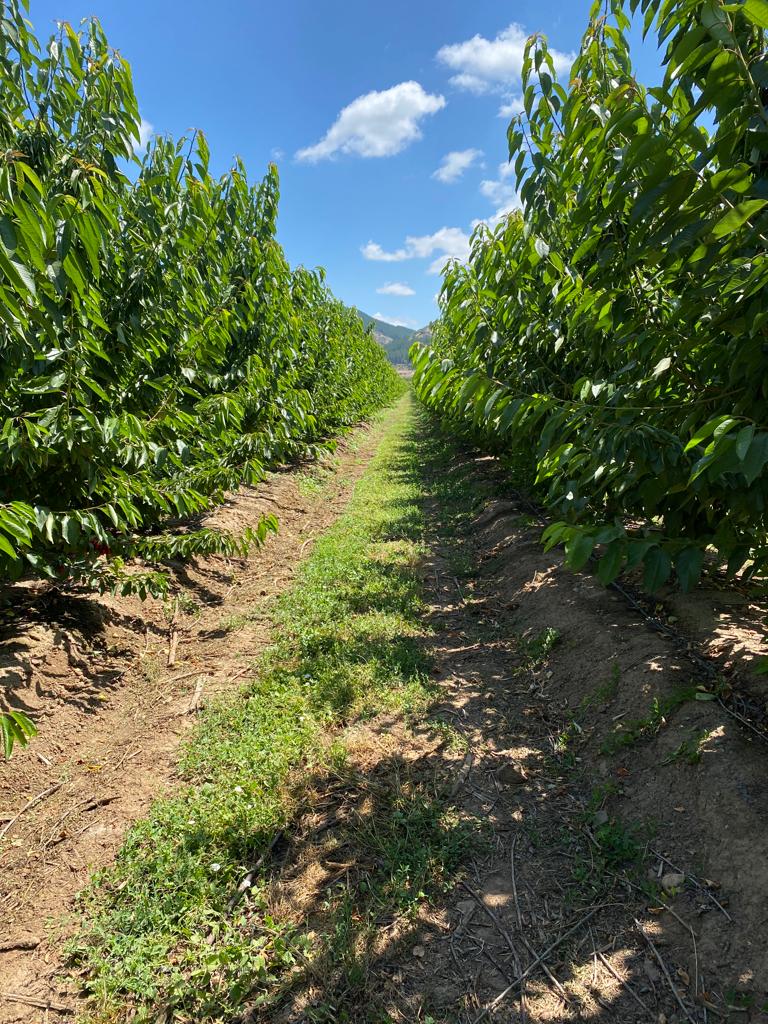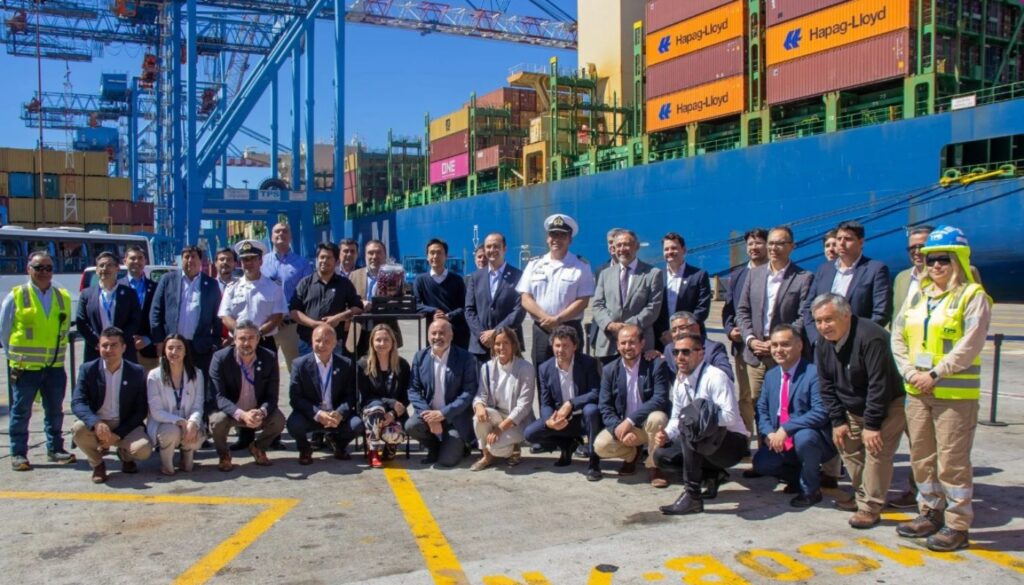By: Ricardo Miño Astorga, Agricultural Engineer

The world of “agro” Throughout history, it has had to adapt to multiple conditions and variants that have allowed it to continuously improve innovation in the tools and solutions of those who work in the sector. Each advance, each new implement has been born from the need to adapt to a new scenario. And this is also how DESH (Double Axle on Row) was born, the cherry tree training system created by the Chilean agricultural engineer Ricardo Miño Astorga.
Ricardo Miño has more than 23 years of experience in the agricultural sector and has worked for important companies producing and exporting fresh fruit. During this time he participated in the planting and development of many orchards of different species, mainly cherry trees, and in turn many varieties and different training systems (Spanish vase, axis, Y-trellis, Tatura, etc.).
In 2011, thanks to his persistence and vision, he was faced with a situation that was no less real in many cases of reconversion: planting a block of cherry trees on a block of kiwis, but with the condition that “he should not uproot the kiwis and use the minimum resources”.
“It was then that I put the rootstocks between two kiwi plants and grafted them in the ground. The plant was another innovation: Colt rootstock with a dwarfing rootstock bridge. The variety chosen for the area, cv. Royal Dawn with Lapins as a pollinator. For at least one year, I had to have the cherry trees coexist with an already formed kiwi plant. This “experiment” had 10 ha, in a planting frame, according to the kiwi plantation: 4.0 X 2.5 m., and according to my experience I had two options to form the orchard, in a single axis or in a double axis.” said Miño.
Since the height of the trellis was 2.2 m and forming it on a single axis meant removing the structure, and it was also clear that the bridge pattern, although it is true that it would reduce the vigor with respect to a Colt, it was not known how much, it was at that moment that Ricardo Miño thought of forming it on a double axis and to reduce the vigor he had to incline it at least 60°, but on the row. They already had experience with Tatura and Y-Trellis, so there were two points against: a large financial investment could not be made and also he wanted freedom of movement between the rows, which is not obtained with these systems.
At the end of that first season, the plants grew relatively well; on an 80% both axles reached 2.2 m. During that year, he imagined the management of the laterals and was convinced to guide them at a 90° angle to the axle, towards the inter-row. He was authorized to tear up the kiwi orchard, and the owner, still not very convinced, let him continue with the project, “with the minimum resources, because you will surely have to redo it,” he was told.
The second year, management was carried out to stimulate sprouting. Now the question was how to make the sides remain at right angles to the axes.
Optimizing what was in the field, he used “cañaveral” rods, much weaker than a coligüe, but it did its job, at least that first year. Then, the following two years he continued forming and homogenizing the orchard and devising a way to guide the sides without using tutors. They were struck by the rapid enlargement of each side. At first they attributed it to the Gisela 6 bridge. The height of each axis is 2.2 m, 14 sides were left per axis, 28 sides per plant. The maximum length of each side is 1 m. to leave two meters free between the rows for the tractor to pass. The sides begin to form from 70 cm from the ground.
The first harvest was obtained on October 30, 2014. And the initial plan was fulfilled; the harvest was completely pedestrian and easy to carry out. The staff had no experience in cherry harvesting and they carried it out without any major problems. The production was 3 tons/ha. Until today, this project has consistently produced between 13 and 14 tons/ha of fruit of extraordinary firmness and size.
“Since the first year I have tried to improve this system, I always thought that it is an optimal system to transform a kiwi orchard or grape vine into cherry trees. I have invited many colleagues to make critiques or contribute ideas. Many good conclusions have been obtained from such visits." added the expert.
The basic structure of this system must be a trellis with central posts at 20 m., headers and a perimeter, therefore, the use of corner posts is also essential. All at 3.5 m. high (at least).
Three wires are used in the fabric, one in the centre of the row and two 70 cm on each side of the central wire. The central wire is used to fix the axes and the lateral wires are used to guide the arms. This is a possible weakness of this system, since up to now, the best way to guide the lateral wires and ensure their position is by placing a stake 70 cm from the neck of the plant on each side towards the inter-row. From this stake, a wire is projected towards the aerial fabric at an angle identical to each axis. The lateral wires are tied to the wire. In other words, the orthopaedics is carried out on this structure. Afterwards, this stake and the wire are not removed any more, therefore, mechanised tasks such as applying herbicide are made more difficult, but it is what has worked best and allowed the garden to be formed perfectly.
This system reduces vigour considerably, making it ideal for strong combinations. The ideal planting frame is 4 X 2 m, that is, 1250 plants per hectare. It also works for other densities.
The most important thing is the distance between the rows. 2 metres allow for a 60° angle. At a shorter distance, this angle is smaller, therefore, the vigour control is also less. Greater distance is recommended in very good, deep and drained soil.
Regarding the initial cost of structure and labor, it is broken down as follows:


This is how the DESH system has evolved in several cherry production areas in the central zone, with a good adaptation period and good results in terms of production potential.
“This year, once we saw the results in terms of productivity, size curve and ease of harvest, we were absolutely convinced that it is a very interesting and easy-to-manage system. The additional initial costs of almost US$1,000/ha are offset by the precocity, efficiency and rapid return on the initial investment.” Miño emphasized.
For his part, Carlos Tapia, director of Avium commented: “No cherry training system should be the target of criticism, which is often unfounded and based on little knowledge of the management, the “pros” and cons of each one… generally almost like “hallway comments”. A training system depends on many important factors such as variety, rootstock, soil, climate, etc. But I personally believe that one of the most important factors is the confidence, seriousness and discipline that each producer puts into achieving the objective. Doing it very well is synonymous with success in the short or medium term, but never lose sight of the fact that the main objective of each one is to be able to maximize the production potential maintained over time.
Although there are so-called “management recipes” to form each driving system, success or failure is closely related to the producer’s management in terms of the moment and technique of each management. And my comment is even for those that are better known or more used, such as the central axis.












